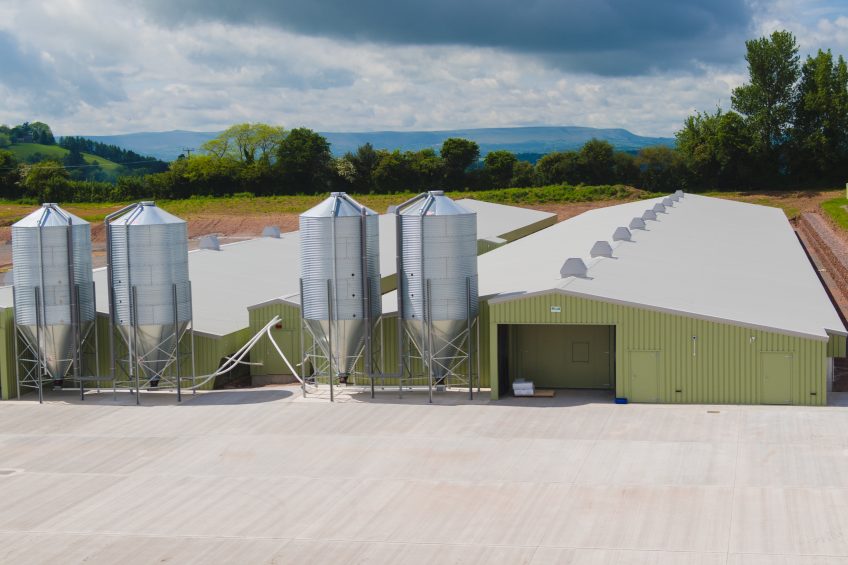Getting ventilation right on broiler farms

Correct airflow is fundamental to a healthy and productive poultry flock. Here, we review the basic steps to achieving fresh air at the right temperature.
Ventilation is one of the most crucial elements in broiler welfare and production, according to John Lack of ventilation specialists Hydor.
The right system not only ensures adequate air exchange throughout the broiler house, but also removes excess moisture from the litter, maintains oxygen and carbon dioxide levels, and regulates temperature within the house.
Aims and legislation
Legally there are certain air quality requirements that a ventilation system must be able to provide.
- Dust particles <1mg sq m>
- Humidity <84%>
- Ammonia <20ppm>
- Carbon dioxide <0.5%>
However, the aims for air quality should go beyond the basic legal requirements and look to providing the best environment possible for bird welfare, health and production.
Ventilation System Types
By far the most common set-up in the UK is a ridge-extraction, side-inlet system.
Fans sited in the roof apex draw warm, moist air up through the house and out through the ridge. Removing the air creates negative pressure in the airspace, drawing fresh cool air in through the inlets mounted along the side of the house.
Side extraction systems, which removed air through the sides of the housing, became effectively obsolete with the introduction of Integrated Pollution Prevention and Control (IPPC) legislation. Side extraction systems fell afoul of the law because dust and debris drawn out of the house was ejected at too low a height.
Likewise, cross ventilation systems which drew air in on one side, across the top of the flock and then vented it on the opposite side, also contravened the IPPC rules.
The only other system which is currently in use in the UK is tunnel ventilation. This draws air in high up in the gable end, along the ridge and out through the opposing gable. It is less efficient than the commonly used ridge extraction system and largely confined to being an additional source of airflow in high temperatures.
Poor ventilation signs
Monitoring equipment and comparison of graphs from data collected on temperature and air quality should provide an early warning of anything awry. Key indicators such as changes in water or feed intakes, should spark investigation of the ventilation system.
Aside from the automatic monitoring, any problems with the ventilation system should be detectable from the atmosphere in the broiler house. If the environment feels comfortable to stand in then it is very likely that the ventilation system is working well. But if the air feels uncomfortably muggy or close and there is a smell of ammonia, then temperature, oxygen and humidity levels must be investigated straight away.

Hydor general manager John Lack. Photo: jamesbastable.co.uk
Other tell-tale signs include sporadic bird behaviour such as an uneven flock distribution across the floor of the house. Clustering away from parts of the shed or birds that are hunkered down could indicate that the air is not being circulated properly and cold air spots have formed. If the conditions are left to continue birds may start to show respiratory difficulties.
In contrast when birds are too hot they may move apart, pant or raise their wings. Reduced feed intake or a spike in water consumption can also indicate a shed is too hot.
Maintaining control as conditions change
For the first few days after placement ventilation should be set to promote higher relative humidity levels between 60-70%. This allows mucus membranes in the respiratory tract to develop. Too low a level and the pulmonary and circulatory systems may be affected. After this initial period, humidity can be lowered to 55-60%.
Aside from age the biggest influence on air quality are the conditions outside the housing. Hot summer weather and freezing conditions in the winter must be controlled by the ventilation system to achieve an even environment inside the shed.
Summer
An increase in body temperature of 4°C can cause fatalities, but many of the deaths attributed to hot weather are when humidity rises in tandem with temperature.
To lose body heat birds pant but the physiological mechanism requires abundant fresh, dry air. So, when temperatures exceed 25°C in summer, it is important to deliver as much fresh air at bird height as possible. This means setting inlets to a wider opening, to direct cool air lower down.
As well as roof extraction, it is possible to install fans in the gable ends of a building. For most of the year these fans remain unused but if temperatures rise the additional capability kicks in and can quickly bring conditions back under control.
Winter
In contrast to summer controls, it is important to stop cold air accumulating at flock height when the temperature cools. When birds are cold, growth rates slow down and welfare can be compromised by other health issues such as hock burn. Hock burn occurs when bedding becomes wet due to condensation in cold air accumulation at low levels.
Inlets in the winter should be narrowed so that air comes in at a higher pressure and angled to force airflows upward and away from directly chilling the flock at floor level. Closing up side inlets to ensure cold air is forced along the ceiling towards the roof fans means that as it drops it loses some of its humidity and heats up before reaching the floor.

Heating further complicates the picture in the winter, particularly with older systems. Although higher temperatures can help reduce excess moisture, gas heaters use up about 15l of air to burn 1l of propane while producing CO2 and water. Opening the ventilation to remove these can in turn bring in cold, moist air which requires further heating so creating a vicious cycle, and the ventilation system starts to fight itself. For this reason, modern systems function using more sophisticated software that creates margins around measurements of CO2, ammonia and moisture. The degree of flexibility means the system gradually levels these elements out rather than making knee-jerk reactions one after another.
Finding equipment problems
Preventing problems from arising is the key to maintaining good performance and welfare. Working closely with an adviser, consultant or company technician can help spot potential problems early and reduce the chance of encountering more serious difficulties.
For example, testing air movement using a more expensive smoke puffer rather than using a cruder can quickly highlight distinct problem areas. The puffer emits a five-second burst indicating more precisely dead spots caused by design failings or faulty equipment. It may highlight major problems like insufficient fan numbers or simpler issues such as poor fan staging that is biased to one end of the house.
Regular testing of the fan motors by a qualified electrician could identify amperage anomalies. This could suggest a problem in the making, long before a failure triggers an alarm or even worse, puts the flock at risk.
It is also well worth ensuring that temperature sensors are sited correctly at the right height and in large enough numbers across the house to give reliable readings. Houses are generally warmer in the middle – relying on too few sensors can lead to temperature discrepancies, poor performance and compromised welfare.
Inlets are often at the root of difficulties either because they have been sited badly or the mechanism has been allowed to fail due to poor maintenance. It is vital that these are tested and opening and closing fully to prevent draughts or overheating.
Calculating ventilation Calculating ventilation system requirements to create sufficient air exchange and meet quality aims is relatively simple. The most important piece of information to establish is the maximum stocking density (or peak total flock weight) that will occur during each crop of birds. That means working out what the maximum weight of each bird will be, multiplied by the number of birds in the flock. It is crucial to establish the total, both before and after thinning and base the peak ventilation requirement on whichever is the larger figure. For example, at thinning on day 32-34 a flock of 40,000 birds weighing 1.8kg each would amount to a total stocking density of 72,000kg. If 5,000 birds are then thinned out the 35,000 remaining would go on to reach a maximum average liveweight of 2.2kg/head and a total flock weight of 77,000kg. This figure should, therefore, be used to work out how much air movement is needed. With the total weight confirmed it is then possible to work out the capacity of the ventilation system using an established conversion figure as a multiplier. Hydor uses a conversion figure of 4.75 m3/hour/kg liveweight to arrive initially at a quantity of air removed per hour. This conversion figure varies between equipment suppliers but 4.75 will ensure that the system will cope in extreme conditions. For example, using a maximum flock weight of 50,000kg the air movement required per hour would be 237,500m3/hr. To arrive at an airflow per second this is then divided by 3,600 (the number of seconds in each hour). The final air movement required would therefore be 66 m3/s. From that it is possible to calculate how many roof fans are needed. With Hydor’s HXRU vertical agri-jet 800mm diameter fan that would require a total of 14 extraction units sited in the apex. For each fan, a total of eight inlets in the sides of the building are needed to draw in the total amount of air. In the case of the above example, that would require 112 inlets to be able to draw in the 66m3/s peak required. Two winch motors are needed – one for each side of the shed – to raise and lower the inlet flaps and a 0.67kw motor for each of the fans. |
Maintenance
A systematic maintenance programme based around a checklist of tasks could save time and money.
Inlets should all be cleaned to ensure they are free from dirt that can clog gearing and leave it jammed. Cords should be tensioned correctly and adjusted to ensure they are opening to the same degree down the full length of the shed. Of equal importance is cleaning the exhausts. This is often overlooked but it is vital to ensure that the airway is clear from trash and debris which will accumulate over time. Another common mistake is at turnaround when over-zealous cleaning and disinfection by contractors can create problems. Cleaning agents can be corrosive and damage the sensitive ventilation mechanisms.
Often cleaning teams will start in the same place and the initial burst of detergent can be at a higher concentration. Over a number of cycles this can lead to corrosion damage to inlet motors and gearing if the start position is not varied. Checking with the cleaning team and asking them to use a lower PSI in their pressure washer, particularly around sensitive electrics, could yield benefits. Frequently, damage is caused by water ingress into sensors and motors from high-pressure jets. A final check around before the new crop is introduced will also reduce the common mistake of leaving sensors in their stowed position.













